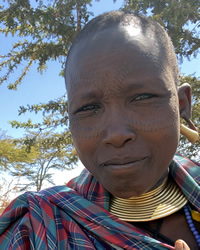Datooga in Tanzania

Photo Source:
Anonymous
|
Send Joshua Project a map of this people group.
|
| People Name: | Datooga |
| Country: | Tanzania |
| 10/40 Window: | No |
| Population: | 16,000 |
| World Population: | 16,000 |
| Primary Language: | Datooga |
| Primary Religion: | Ethnic Religions |
| Christian Adherents: | 25.00 % |
| Evangelicals: | 4.00 % |
| Scripture: | Complete Bible |
| Ministry Resources: | Yes |
| Jesus Film: | Yes |
| Audio Recordings: | Yes |
| People Cluster: | Nilotic |
| Affinity Bloc: | Sub-Saharan Peoples |
| Progress Level: |
|
Introduction / History
The most general name for this widely dispersed ethnic group is Datooga. The best known and most numerous sub-tribe of the Datooga peoples are the pastoral Barabaig, who reside chiefly in that part of the northern volcanic highlands dominated by Mount Hanang (3418m), whose scared nature makes it an important theme in Barabaig myth and song.
The Datooga keep goats, sheep, donkeys and a few chickens, but cattle are by far the most important domestic animal. The meat, fat, blood, milk, hide, horns, tendons and cow dung of every animal have either practical or ritual purposes. They were formerly nomadic, depending largely on milk products for their diet, and moving whenever the needs of their cattle dictated. Now, however, many farm a plot of maize and sometimes beans and millet.
The Datooga themselves blend in with their environment, their dress being the color of the reddish brown soil. Only on closer inspection will they appear colorful with their reddish, patched leather dresses, bead work, and brass bracelets and necklaces.
The Datooga are a proud people, with a reputation as fierce warriors. Traditionally, young men had to prove themselves by killing an "enemy of the people", defined as any human being not a Datooga, or one of the dangerous wild animals, such as elephant, lion or buffalo.
They are resistant to cultural change, including belief in Christianity, maintaining a strong adherence to traditional animist beliefs and practices. Since most Datooga do not speak Swahili, the national language of Tanzania, and very few are literate, communication of the gospel must be in their own language, using the traditional media of story-telling and songs. Like animists the world over, the good news of Jesus Christ is very relevant to their needs, once communication can be established.